في الفريق عالي الأداء، يعرف الجميع بالضبط ما هو مسؤول عنه، وكيف يعمل، وكيف يرتبط كل ذلك بأهداف المؤسسة.
هذه الفرق، التي تعمل كوحدة واحدة وتحقق أهدافها باستمرار، لديها عادة واحدة مشتركة: فهي تتبع وتعرف أرقامها في جميع الأوقات.
لا يمكنك تحسين ما لا تقيسه.
بيتر دراكر
الخطوة الأولى نحو تحسين الأداء إذن هي القياس. وهذا يقودنا إلى مفهوم مؤشرات الأداء الرئيسية أو مؤشرات الأداء الرئيسية. تساعد مؤشرات الأداء الرئيسية على قياس أداء الأفراد والفرق والمؤسسة بأكملها بشكل مستمر.
ومع ذلك, إعداد مؤشرات الأداء الرئيسية هو الخطوة الأولى فقط.
يجب عليك أيضًا مراقبة تقدمك بانتظام للتأكد من قدرتك أنت وفريقك على تحقيق أهدافك. وهنا يأتي دور لوحة معلومات مؤشرات الأداء الرئيسية! 📈
ما هي لوحة معلومات مؤشرات الأداء الرئيسية؟
تمثل لوحة معلومات مؤشرات الأداء الرئيسية بصريًا مؤشرات الأداء الرئيسية الخاصة بك، مما يمنحك عرضًا تفصيليًا لـ مؤشرات الأداء الرئيسية المتعددة في مكان واحد. وباستخدام الرسوم البيانية والمخططات وأشرطة التقدم وما إلى ذلك، تساعدك لوحة معلومات مؤشرات الأداء الرئيسية على معرفة موقفك أو موقف فريقك بسرعة مقابل أهداف محددة. يمكنك أن تقيس على الفور مدى قربك من الوصول إلى المعايير.
توفر لوحات مؤشرات الأداء الرئيسية لجميع أصحاب المصلحة فهماً واضحاً لأداء المؤسسة في جميع الأوقات. وهذا يساعد على تحديد مجالات المشاكل واتخاذ الإجراءات التصحيحية عند الحاجة.
إليك كيفية مساعدة لوحة مؤشرات الأداء الرئيسية للأعمال:
- تعرض البيانات لسهولة فهمها: تجمع لوحة مؤشرات الأداء الرئيسية البيانات المعقدة من مصادر مختلفة في عرض واحد موجز. وهذا يساعد في تتبع الأداء ويجعل من السهل تحديد الاتجاهات
- تتبع التقدم المحرز نحو أهداف محددة: استخدامالمقاييس الكميةتساعد لوحة المعلومات الفرق على فهم أدائها مقابل الأهداف. على سبيل المثال، قد يتتبع فريق التسويق مؤشرات الأداء الرئيسية مثل عدد زيارات الموقع الإلكتروني، ومعدلات المحادثات، وتكلفة اكتساب العملاء (CAC)، وما إلى ذلك لفهم كيفية أدائهم
- يساعد في اتخاذ القرارات: يمكن أن تكشف لوحة مؤشرات الأداء الرئيسية عن رؤى تساعدك أنت وفريقك على اتخاذ قرارات أفضل. على سبيل المثال، في الأسبوع الذي ينخفض فيه عدد العملاء المحتملين على الموقع الإلكتروني، يمكن أن توضح لك لوحة معلومات مؤشرات الأداء الرئيسية التسويقية ما إذا كان ذلك مرتبطًا بانخفاض عدد الزيارات
- تحسن التواصل والمواءمة بين الأقسام: تساعد لوحات مؤشرات الأداء الرئيسية الفرق في الحصول على نفس الرؤية الشفافة للأهداف والتقدم المحرز نحو تحقيقها. وهذا يحافظ على توافق الأقسام المختلفة على الأهداف المشتركة
تقوم لوحات مؤشرات الأداء الرئيسية الحديثة بتجميع مؤشرات الأداء الرئيسية المتعددة في عرض واحد، مما يوفر الوقت الذي كنت ستقضيه في تحليل البيانات من مصادر متعددة.
تساعد طرق العرض المشتركة فرق العمل على تحليل الأداء بشكل تعاوني والاستفادة من البيانات والمقاييس لقياس التقدم المحرز.
هل أنت جديد على مؤشرات الأداء الرئيسية؟ شاهد مقطع الفيديو الخاص بنا الذي يزيل الغموض عن مؤشرات الأداء الرئيسية بشكل نهائي!
## عناصر لوحة مؤشرات الأداء الرئيسية
لوحة مؤشرات الأداء الرئيسية هي أكثر من مجرد أداة تتبع: فهي تقدم لمحة سريعة عن المواعيد النهائية الوشيكة والمهام التي تحتاج إلى اهتمام عاجل، إلى جانب أصحاب كل منها. ويؤدي هذا المستوى من الوضوح والمساءلة إلى اتخاذ قرارات مستنيرة وإجراء تعديلات في الوقت المناسب، حتى تتمكن من الحفاظ على الزخم نحو تحقيق الأهداف.
عادةً ما تحتوي لوحة مؤشرات الأداء الرئيسية المصممة جيدًا على هذه العناصر:
المقاييس الرئيسية
ستعرض لوحة مؤشرات الأداء الرئيسية أهم المقاييس ذات الصلة بالفريق والمؤسسة. عادةً ما يكون كل مقياس من المقاييس محددًا وقابلًا للقياس الكمي وقابلًا للقياس. على سبيل المثال, المقاييس الرئيسية لفريق إدارة المنتج يمكن أن تشمل معدل اعتماد الميزات، وصافي نقاط المروجين (NPS)، ومعدل الاحتفاظ بالمستخدمين، ودرجة رضا العملاء (CSAT)، وما إلى ذلك.
تصور البيانات
قد لا تكون المخططات الدائرية البسيطة وقوائم الأرقام كافية لتتبع تقدمك بدقة. بدلاً من ذلك، يجب أن تبحث عن لوحة معلومات تنفيذية تقدم رؤى شاملة من خلال عناصر مرئية. عناصر مثل الرسوم البيانية، والمقاييس، ومقاييس الحرارة، وأشرطة التقدم تجعل مراقبة التقدم أسهل.
لوحة معلومات مؤشرات الأداء الرئيسية التي تصور البيانات من خلال المخططات والرسوم البيانية وبطاقات الأداء وما إلى ذلك، تسهل على الفرق فهم البيانات وتحليلها بسرعة واتخاذ قرار بشأن الخطوات التالية.

تصوُّر مؤشرات الأداء الرئيسية الأساسية مثل سرعة العدو السريع في لوحات معلومات ClickUp
تحديثات في الوقت الفعلي
أنت تريد لوحة معلومات تحتوي على أحدث البيانات وأكثرها موثوقية، حتى تتمكن من اتخاذ قرارات مستنيرة واتخاذ إجراءات في الوقت المناسب. من الناحية المثالية، يجب أن تكون لوحة معلومات مؤشرات الأداء الرئيسية الخاصة بك قادرة على تحديث البيانات تلقائيًا في الوقت الفعلي أو على فترات متكررة. وهذا يضمن أن تكون المعلومات التي تنظر إليها حديثة وموثوقة دائماً.
في حين أن العديد من الفرق لا تزال تنشئ لوحات معلومات مؤشرات الأداء الرئيسية في Excel ، فإن العيب الكبير هو أنها لن تبقى محدثة تلقائيًا. يمكن للأدوات الحديثة القيام بذلك بشكل أفضل من خلال التكامل مع مصادر البيانات الخاصة بك.
خيارات التصفية والتنقل لأسفل
تمنحك لوحات المعلومات الأكثر تقدمًا خيارات التصفية والتنقل إلى الأسفل ل رؤية مقاييس محددة بتفاصيل أكثر دقة. على سبيل المثال، تحتوي لوحات معلومات ClickUp Dashboards على فلاتر ومفاتيح تبديل لمساعدتك في العثور على المعلومات الضرورية.

التعمق في أي مقياس في لوحة معلومات مؤشرات الأداء الرئيسية باستخدام الفلاتر في ClickUp
### المعالم والجداول الزمنية
من المهم لقائد الفريق تحديد المعالم الرئيسية للحفاظ على معنويات الفريق، خاصة بالنسبة للأهداف طويلة المدى. فهي بمثابة نقاط مرجعية توفر التشجيع من خلال علامات التقدم المرئية.
من ناحية أخرى، تمنحك الجداول الزمنية أنت وفريقك بأكمله خارطة طريق واضحة لتحقيق الأهداف، مما يساعدك على الحفاظ على الحافز والتركيز. يجب أن تكون لوحة معلومات مؤشرات الأداء الرئيسية الخاصة بك قادرة على دمج هذه المؤشرات مع مقاييس الأداء.

تحديد الأهداف وتتبعها لتحويل الإنجازات إلى لحظات فخر للفريق مع ClickUp Goals
التخصيص
لا يمكن أن تكون لوحة مؤشرات الأداء الرئيسية مفيدة حقًا إلا عندما يتمكن المستخدمون من تخصيص عرض لوحة التحكم الخاصة بهم. على سبيل المثال، قد يرغب قائد المبيعات فقط في رؤية مؤشرات الأداء الرئيسية للمبيعات بشكل عام وإضافة عوامل تصفية حسب الفرق. من ناحية أخرى، قد يرغب رئيس القسم في رؤية مؤشرات الأداء الرئيسية التفصيلية للفريق والأداء الفردي في تخطيط محدد.
يجب أن تكون لوحة التحكم الخاصة بك قابلة للتخصيص حتى لا تضطر إلى إنشاء لوحات تحكم متعددة لمؤشرات الأداء الرئيسية مصممة خصيصًا لتلبية المتطلبات الفريدة لكل فريق. يمكنك أيضًا إنشاء قالب مشترك للوحة المعلومات يمكن إعادة استخدامه حسب الحاجة.
💡 نصيحة احترافية: ClickUp Dashboards قابلة للتخصيص بدرجة كبيرة، مع أكثر من 50 أداة لإنشاء طريقة عرض البيانات المفضلة لديك.

_تفصيل الأهداف والمهام والنقاط الرشيقة وحالات المشروع في لوحة معلومات ClickUp 3.0 القابلة للتخصيص بدرجة كبيرة
الإشعارات
بعض تقارير مؤشرات الأداء الرئيسية تسمح لك الأدوات بإعداد تنبيهات وإشعارات لأحداث محددة تتطلب تدخلاً أو إجراءً سريعًا. على سبيل المثال، يمكنك إعداد تنبيه عندما تنخفض حركة المرور على موقعك الإلكتروني بأكثر من 10% خلال أسبوع.
واجهة سهلة الاستخدام
لوحة تحكم مؤشرات الأداء الرئيسية هي أداة لكل شخص في المؤسسة، وليس فقط للأشخاص المتمرسين في مجال التكنولوجيا. يجب أن يكون تصميمها بديهيًا وسهل الاستخدام، مما يتيح سهولة التصفح. يجب أن تكون جميع الرؤى الرئيسية سهلة الوصول إليها حتى لا يضطر أعضاء الفريق إلى البحث بشكل مكثف عن بيانات الأعمال المهمة. بالإضافة إلى ذلك، فإن جعل لوحة المعلومات سهلة الاستخدام على الهاتف المحمول يعزز فائدتها حيث يمكن للفرق تتبع التحديثات المهمة في أي مكان وزمان.
كمحلل أعمال، جعلت ميزة لوحة المعلومات في ClickUp من السهل جدًا تصوير البيانات بطريقة جميلة وهادفة. تحتوي خاصية المقارنة على تخصيص يمكن من خلاله عرض البيانات بطريقة كاملة المعنى ويمكن فهمها بسهولة شديدة
شيخا شاتورفيدي، محلل أعمال، شركة سيدكوس تكنولوجيز الخاصة المحدودة
الآن وقد عرفنا ما تتكون منه لوحة معلومات فعالة لمؤشرات الأداء الرئيسية، دعنا الآن أيضًا نجيب عن السؤال الوحيد الذي يحير الكثيرين، وهو الفرق بين OKRs ومؤشرات الأداء الرئيسية.
## الفرق بين مؤشرات الأداء الرئيسية ومعدلات الأداء الرئيسية
بينما تُستخدم مؤشرات الأداء الرئيسية ومعدلات الأداء الرئيسية لقياس الأداء وتتبعه، إلا أن الغرض منها وخصائصها تختلف. فبينما تقيس مؤشرات الأداء الرئيسية أداءك مقابل مقاييس محددة، فإن مؤشرات الأداء الرئيسية تقيس أداءك مقابل مقاييس محددة، بينما تحدد OKRs رؤيتك واستراتيجيتك لتحقيق أهدافك. إليك مقارنة سريعة بين الاثنين:
جدول يسلط الضوء على الاختلافات بين مؤشرات الأداء الرئيسية ومراجع الأداء الرئيسية
| ------------------ | ----------------------------------------------------------------------------------------------------- | --------------------------------------------------------------------------------------------------------------------------------------------------- |
| الغرض | لقياس ومراقبة الأداء بشكل مستمر | لتحديد وتتبع الأهداف والنتائج القابلة للقياس |
| الإطار الزمني المشمول | مستمر | عادةً ما يكون ربع سنوي أو سنوي |
| التركيز | تتبع الأداء الفردي أو أداء الفريق مقابل أهداف محددة مسبقًا | مواءمة وتحريك الأفراد أو الفرق نحو تحقيق أهداف محددة |
| ماذا يقيسون | نقاط البيانات الكمية | نتائج رئيسية قابلة للقياس الكمي مرتبطة بالأهداف |
| الهيكلية | وصفية وتتضمن مقاييس فردية | وصفية وتدفع التقدم نحو تحقيق الأهداف |
| المرونة | ثابتة طوال المدة ما لم يكن هناك تغيير في الأهداف | يتم تحديثها ومراجعتها عند الحاجة |
| مثال | عدد الزيارات للموقع الإلكتروني |العملاء المحتملين شهرياً |إيرادات المبيعات |الإيرادات اليومية |تكلفة اكتساب العملاء |زيادة عدد الزيارات للموقع الإلكتروني بنسبة 50%زيادة عدد الزيارات للموقع الإلكتروني بنسبة 20% زيادة الإيرادات بنسبة 25% تحسين التحويلات بنسبة 18% تحسين درجة CSAT بنسبة 10% تقليل تكلفة اكتساب العملاء بنسبة 15%
## أنواع مختلفة من لوحات مؤشرات الأداء الرئيسية
تختلف لوحات معلومات مؤشرات الأداء الرئيسية من حيث التصميم والوظائف لتلبية الاحتياجات المحددة لكل دور، من الرؤساء التنفيذيين إلى المديرين وقادة الفرق والمساهمين الأفراد داخل المؤسسة.
يمكن أن يساعدك فهم الميزات والأغراض المميزة لكل منها على تنفيذ إطار عمل مؤشرات الأداء الرئيسية الأكثر ملاءمة بفعالية.
لوحة مؤشرات الأداء الرئيسية الاستراتيجية
يحتاج المديرون التنفيذيون والإدارة العليا في المؤسسة إلى نظرة عامة رفيعة المستوى لأداء الشركة مقابل الأهداف المحددة. توفر لوحة متابعة مؤشرات الأداء الرئيسية الاستراتيجية هذه النظرة العامة للتقدم الذي تحرزه المؤسسة نحو الأهداف الاستراتيجية والأهداف طويلة الأجل. وستتضمن نظرة عامة على صحة الأعمال والبيانات على مستوى الشركة فيما يتعلق بالأداء المالي ورضا العملاء، وما إلى ذلك.
يوفر هذا النوع من لوحات متابعة مؤشرات الأداء الرئيسية التنفيذية ما يلي:
- تصور الأهداف الاستراتيجية: عرض الأهداف الأساسية للمؤسسة ومواءمتها مع الاستراتيجية الشاملة
- تتبع النتائج على مستوى المؤسسة بأكملها: تقديم رؤى حول أداء الأقسام المختلفة وكيفية مساهمتها في تحقيق أهداف الشركة
- دعم اتخاذ القرارات: بما في ذلك الرؤى والتوقعات القابلة للتنفيذ التي تساعد في التخطيط الاستراتيجي وتخصيص الموارد
- رؤى الأداء في الوقت الحقيقي: تمكين الرؤساء التنفيذيين والمديرين التنفيذيين من مراقبة سلامة المؤسسة والتقدم المحرز نحو تحقيق الأهداف
لوحة معلومات تحليلية لمؤشرات الأداء الرئيسية
تُعد لوحات مؤشرات الأداء الرئيسية التحليلية أكثر دقة من لوحات المعلومات الاستراتيجية وتوفر بيانات ورؤى متعمقة لمساعدة المديرين على اتخاذ القرارات. وعادةً ما تتضمن بيانات وميزات تاريخية، مثل الفلاتر والعروض، لإجراء تحليل أعمق. سيستخدم المحللون وعلماء البيانات في مؤسستك لوحات المعلومات هذه يوميًا. هذه هي أفضل لوحات معلومات مؤشرات الأداء الرئيسية التي يمكن استخدامها للتخطيط والاستراتيجية على المدى الطويل.
تستخدم بعض المؤسسات لوحة معلومات تحليلية كمصدر رئيسي للبيانات الرئيسية للرؤى، مع إجراء تخفيضات مختلفة لفرق أو وظائف محددة.
لوحة معلومات مؤشرات الأداء الرئيسية التشغيلية

إنشاء مجموعة من لوحات المعلومات التشغيلية وتخصيصها في ClickUp
النوع الأكثر استخدامًا من لوحات مؤشرات الأداء الرئيسية هو لوحة المعلومات التشغيلية. وهذا يعطي لمحة منتظمة عن عمليات عملك في وقت معين. وعادةً ما تفتقر لوحات المعلومات هذه إلى الرتوش مثل طرق العرض المتعددة وأشرطة التقدم؛ وبدلاً من ذلك، فإنها تركز على الأداء أو الحالة الحالية. تتميز لوحات معلومات مؤشرات الأداء الرئيسية التشغيلية أيضًا بتصميم أبسط يسهل استخدامه.
وغالبًا ما يستخدم هذا النوع من لوحات مؤشرات الأداء الرئيسية من قبل قادة الفرق والإدارة الوسطى؛ وتشمل ميزاتها الشائعة ما يلي:
- مؤشرات الأداء الرئيسية الخاصة بالفريق: تفصيل أهداف الفريق وتتبع التقدم المحرز مقابل هذه المقاييس
- أدوات التعاون والمواءمة: ضمان توافق أهداف الفريق مع الأهداف التنظيمية الأوسع وتعزيز التعاون بين أعضاء الفريق
- إدارة الأداء: المساعدة في تقييم أداء الفريق وتحديد مجالات التحسين وتقدير الإنجازات
- تتبع الإنجازات: تسليط الضوء على الإنجازات المهمة والمواعيد النهائية القادمة لإبقاء الفريق متحمسًا وعلى المسار الصحيح
ومن الأمثلة على هذا النوع من لوحات المعلومات لوحة متابعة أداء المبيعات اليومية، وتقرير حضور الفريق، وتتبع أوقات استجابة دعم العملاء، ولوحة متابعة مستوى المخزون، ولوحة متابعة مؤشرات الأداء الرئيسية لمبيعات الشركة، وما إلى ذلك. كما يمكن للفرق المختلفة داخل المؤسسة (المبيعات والتسويق وخدمة العملاء وغيرها) إنشاء لوحات معلومات تشغيلية لتتبع مؤشرات الأداء الرئيسية الوظيفية.
لوحة معلومات مؤشرات الأداء الرئيسية الوظيفية
يجب أن يفهم المساهمون الأفراد كيف يؤثر عملهم على أهداف المؤسسة. تكون لوحة القيادة الخاصة بهم أكثر تكتيكية وتركز على ما يلي:
- الأهداف والمقاييس الفردية: عرض أهداف الفرد والتقدم الذي يحرزه نحو تحقيقها
- إدارة المهام: دمج قوائم المهام ومؤشرات التقدم لمساعدة الأفراد على إدارة عبء العمل وتحديد الأولويات بفعالية
- التغذية الراجعة والتطوير: توفير طرق لتلقي الملاحظات وتتبع التطور والنمو الشخصي داخل المؤسسة
- رؤية المواءمة: إظهار كيفية توافق أهدافهم مع أهداف الفريق والمؤسسة لخلق شعور بالمساهمة والانتماء
لوحة معلومات مؤشرات الأداء الرئيسية لإدارة المشاريع
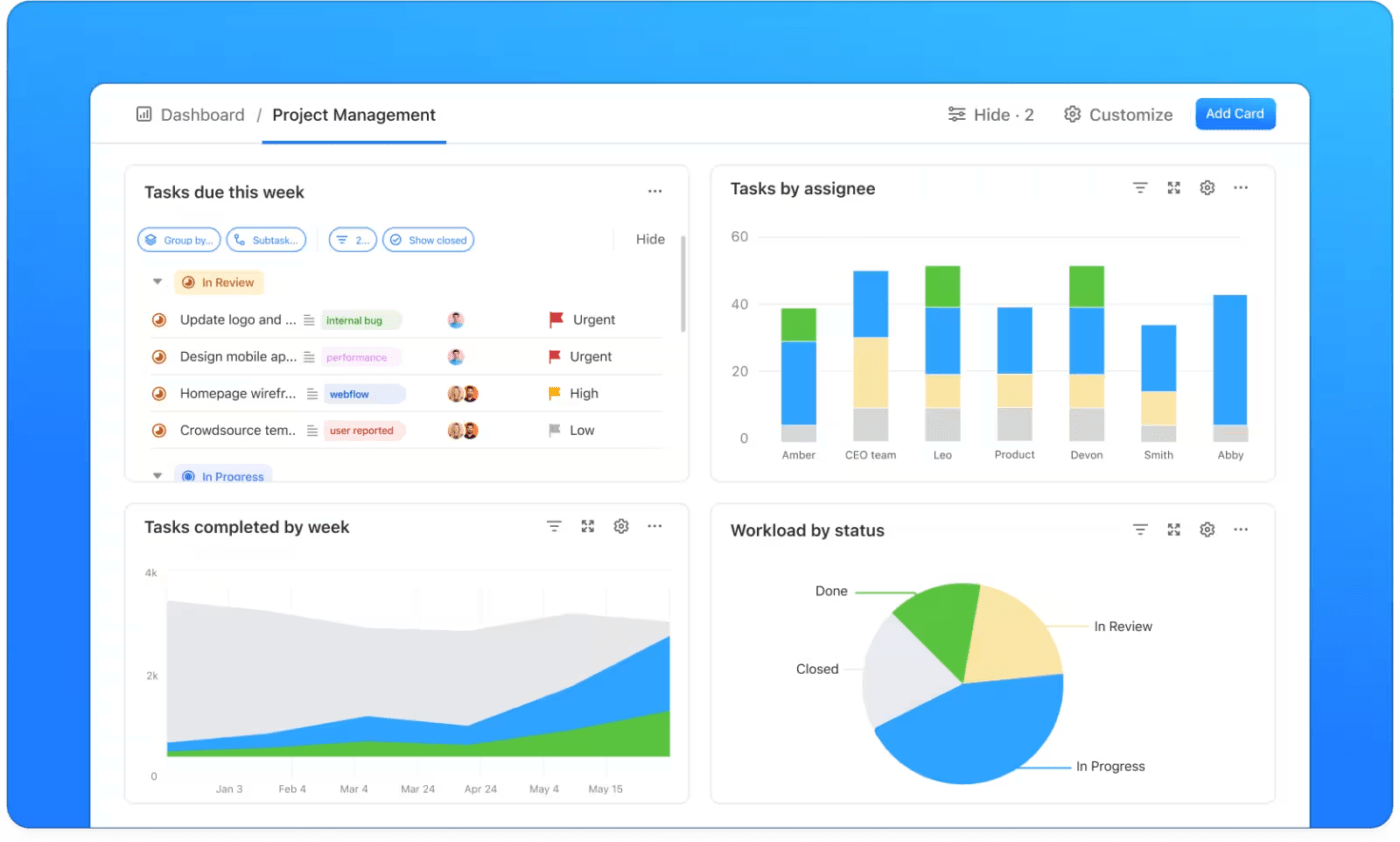
ابق على اطلاع على تقدم مشروعك مع لوحات معلومات ClickUp Dashboards
عادةً ما يكون لدى مديري المشاريع لوحة تحكم منفصلة لكل مشروع من مشاريعهم. يمكن للوحة معلومات مؤشرات الأداء الرئيسية لإدارة المشروع هذه أن تصور كيفية تقدم المشروع وما إذا كان الأداء العام يرقى إلى مستوى التوقعات.
قد تتضمن لوحة المعلومات هذه مؤشرات الأداء الرئيسية المتعلقة بما يلي:
- تخصيص الموارد واستخدامها
- تتبع الوقت
- حالة إنجاز المهام
- استخدام الميزانية
- الجداول الزمنية للمشروع
يساعد مديري المشروع على البقاء على رأس المشروع واتخاذ إجراءات تصحيحية عند الضرورة لإعادة مؤشرات الأداء الرئيسية المحددة إلى المسار الصحيح.
تقوم بعض المؤسسات أيضًا بإنشاء لوحات معلومات مخصصة لمؤشرات الأداء الرئيسية لفرق أو مبادرات محددة. تقوم لوحات المعلومات هذه بتجميع وعرض البيانات الأكثر صلة بكل حالة.
يضمن كل نوع من لوحات مؤشرات الأداء الرئيسية أن يكون كل شخص في المؤسسة، بغض النظر عن دوره، متوافقًا مع الأهداف الاستراتيجية. من خلال توفير البيانات والرؤى ذات الصلة للموظفين على كل مستوى، تسهّل لوحات مؤشرات الأداء الرئيسية اتخاذ القرارات الفعالة وتعزز إدارة الأداء وتروّج لثقافة الشفافية والمساءلة.
اقرأ أيضًا: أنواع
_/مرجع/ https://clickup.com/blog/kpi-scorecards// بطاقات الأداء_KPI *%/href/_
لتتبع مشروعك
## كيفية إنشاء لوحة مؤشرات الأداء الرئيسية
والآن، دعنا نوضح لك كيفية إنشاء لوحة مؤشرات الأداء الرئيسية لنفسك أو لفريقك. تابع معنا!
في حين أنه لا يزال بإمكانك إنشاء ذلك بالطريقة القديمة في ورقة Excel، فإن حل لوحة المعلومات الحديث سيسهل عليك الإدارة اليومية. من بين جميع الخيارات المتاحة، يبرز ClickUp كحل شامل حل شامل لإدارة المشاريع الذي يبسط الهدف وتتبع التقدم المحرز.

إنشاء لوحة معلومات مؤشرات الأداء الرئيسية في ClickUp
### 1. حدد هدفك
قبل إنشاء لوحة معلومات مؤشرات الأداء الرئيسية، يجب عليك تحديد أهدافك. عند تحديد الأهداف، ضع في اعتبارك أنها يجب أن تكون قادرة على تحريكك نحو أهدافك طويلة المدى.
إن أفضل طريقة لتحديد الأهداف ذات الصلة هي اتباع إطار عمل SMART: حدد أهدافًا ذكية ، ذكية ، قابلة للتحقيق، قابلة للتحقيق، قابلة للتحقيق، رواقعية، محددة زمنيًا. إذا لم تكن قد فعلت ذلك من قبل أو كنت تريد توفير الوقت، يمكنك استخدام قالب أهداف ClickUp الذكية لتحديد أهدافك بكفاءة.
قم بتبسيط عملية تحديد أهداف الفريق مع إطار العمل المنظم الذي يوفره قالب الأهداف الذكية من ClickUp SMART Goals
يساعدك هذا القالب القابل للتخصيص على تقسيم الأهداف المعقدة إلى أهداف أصغر وأكثر قابلية للتحقيق. فهو يساعدك على تحديد أهداف محددة وقابلة للقياس وقابلة للتحقيق وذات صلة بالموضوع ومحددة زمنياً.
ستمنحك طريقة عرض ورقة عمل الأهداف الذكية مساحة للعصف الذهني وتخزين جميع أفكارك، بينما تساعدك طريقة عرض أهداف الشركة على تتبع جميع الأهداف التي يعمل عليها فريقك. تنزيل هذا القالب بمجرد الانتهاء من تحديد الأهداف الأكثر أهمية لتتبعها في لوحة مؤشرات الأداء الرئيسية، قم بإنشائها في ClickUp.
💡 نصيحة احترافية: وضع أهداف الفريق؟ قم بإشراك أعضاء الفريق في تحديد الأهداف للحصول على موافقة مبكرة. ClickUp Whiteboards والخرائط الذهنية تجعل التفكير التعاوني والعصف الذهني أمرًا سهلاً.
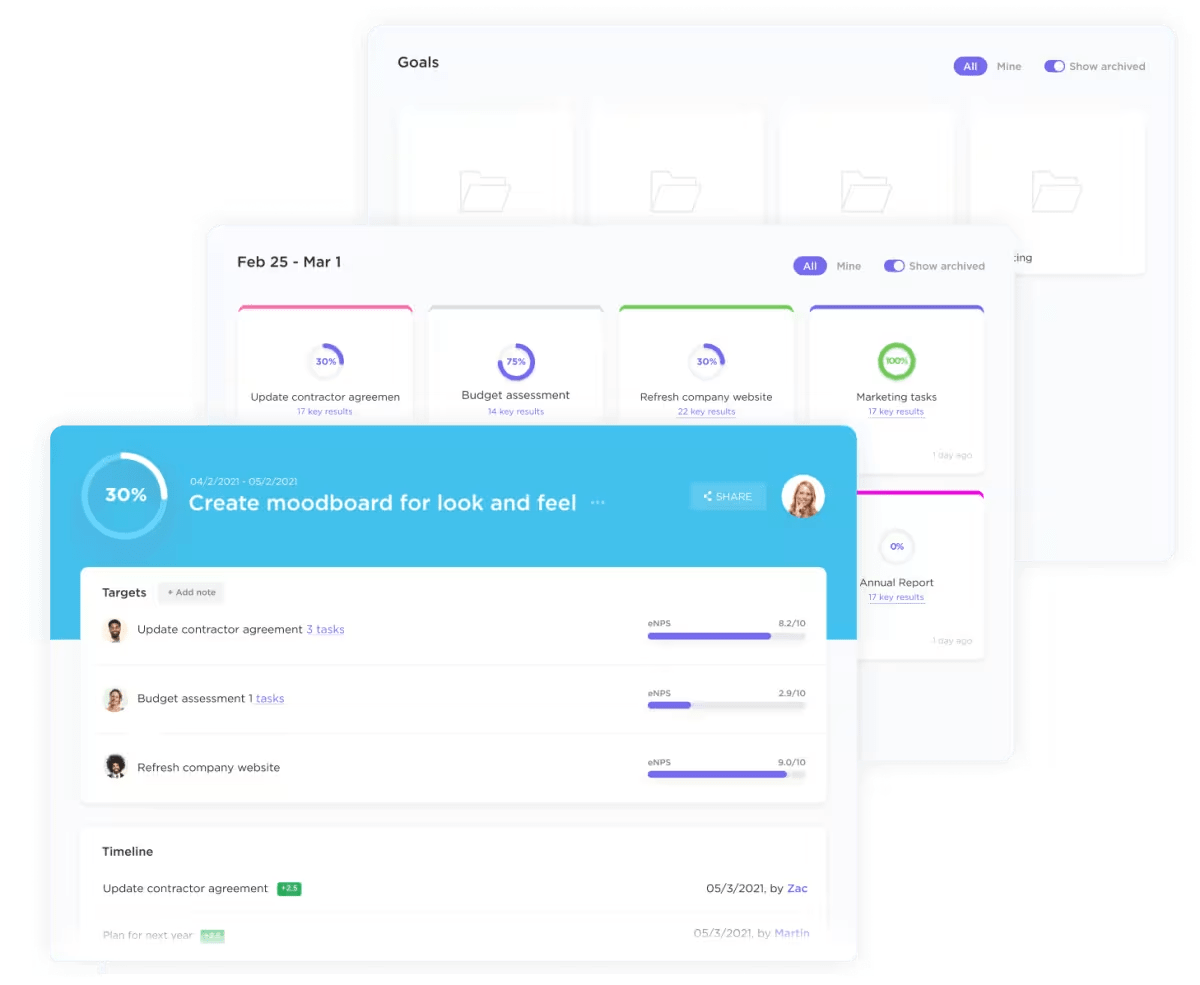
استخدم أهداف ClickUp Goals لتحقيق أهدافك من خلال جداول زمنية واضحة وأهداف قابلة للقياس وتتبع التقدم التلقائي أهداف ClickUp Goals يتيح لك إنشاء أهدافك ومؤشرات الأداء الرئيسية وتتبعها بشكل مرئي وبديهي.
باستخدام ClickUp Goals، يمكنك:
- استخدام عناصر مثل أشرطة التقدم، والمخططات الدائرية، ومقاييس الحرارة لـ تصوير أهدافك ومقاييسك
- ربط أهدافك بالمهام والمهام الفرعية وقوائم المراجعة وتتبع حالتها بشكل فردي
- شارك أهدافك مع فريقك وأصحاب المصلحة واطلع على التقدم المحرز والمواءمة
- قم بتخصيص لوحة مؤشرات الأداء الرئيسية باستخدام حقول مخصصة وطرق عرض متعددة وعمليات تكامل
- أضف تذكيرات وميزات التعليقات للسماح بتحديثات منتظمة ومراجعات للوحة معلومات مؤشرات الأداء الرئيسية الخاصة بك
اقرأ أيضًا: كيفية القيام بذلك
/مرجع/ https://clickup.com/blog/team-goals// تحديد أهداف الفريق /%/href/
بشكل فعال
### 2. تحديد المقاييس ذات الصلة*
والآن بعد أن حددت أهدافك، دعنا نحدد المقاييس التي ستساعدك على قياس تقدمك نحو تحقيقها على أفضل وجه.
على سبيل المثال، قد يكون هدفك هو زيادة الإيرادات بنسبة مئوية معينة. في هذه الحالة، ستحتاج إلى تتبع المقاييس المتعلقة بالعملاء المحتملين والتحويلات ومتوسط قيمة الطلبات وهوامش الربح وما إلى ذلك.
يمكنك إنشاء لوحة معلومات مخصصة في ClickUp لتتبع هذه المقاييس. وهي تُحدِّث البيانات في الوقت الفعلي، لذلك لا داعي للقلق بشأن مدى ملاءمة المعلومات. علاوة على ذلك، يمكنك تتبع مقاييس متعددة في لوحة تحكم واحدة، مما يجعل التحليل أسهل بكثير.
3. حدد الأهداف
بالنسبة لكل مقياس حددته سابقًا، حدد أهدافًا محددة (وواقعية!) ستسعى لتحقيقها. على سبيل المثال، بالنسبة لمقياس التحويلات، يمكنك أن تضع لنفسك هدفًا بنسبة 10% عن تحويلاتك الحالية.
تساعدك الأهداف على قياس مدى تقدمك نحو الهدف في أي وقت وتبقيك على المسار الصحيح.
يتيح لك ClickUp Goals تعيين خمسة أنواع من الأهداف لكل هدف:
- رقم: مجموعة من الأرقام التي يمكنك تتبع الزيادة أو النقصان منها
- صحيح/خطأ: مقياس ثنائي لمعرفة ما إذا كان قد تم تحقيق شيء ما أم لا
- النسبة المئوية: قيمة مئوية لاستخدامها لأشياء مثل معدل الإنجاز وما إلى ذلك
- عملة: قيمة نقدية يمكنك تتبع الزيادة أو النقصان في مقابلها
- مهمة: عندما ترغب ببساطة في تتبع إنجاز مهمة أو مهمة فرعية أو قائمة مهام

حقق أهدافك بأهداف قابلة للقياس وتتبع التقدم التلقائي مع ClickUp Goals
💡 نصيحة احترافية: يمكنك أيضًا استخدام انقر فوق المعالم الرئيسية لتمييز المهام المهمة في مشروعك وتتبعها.
إليك مثال على كيفية إعداد الأهداف في لوحة التحكم لمؤشرات الأداء الرئيسية لفريق دعم العملاء.
قد ترغب في تتبع مقاييس مثل:
- عدد الحالات التي تم التعامل معها
- متوسط درجة CSAT
- متوسط زمن الاستجابة
- عدد حالات التصعيد
لعرضها في لوحة مؤشرات الأداء الرئيسية، يمكنك إضافة عدد الأدوات المصغّرة لقياس الحالات التي تمت معالجتها وحالات التصعيد بشكل مستمر. وبالمثل، يمكنك إضافة أداة تتبع الوقت لتتبع أوقات استجابة دعم العملاء و أداة التقدم لمقاييس تفاعل المستخدم مثل CSAT.
4. دمج مصادر البيانات الخاصة بك
استخدم تكامل ClickUp لأتمتة جمع البيانات حيثما أمكن، مثل ربط برامج دعم العملاء لتتبع أوقات الاستجابة تلقائيًا. تدعم ClickUp عمليات التكامل الأصلية مع العديد من التطبيقات، مثل Slack وEverhour وFront وHubspot، وتتيح لك الاتصال من خلال Zapier بمئات التطبيقات الأخرى. يمكنك أيضًا إنشاء عمليات تكامل مخصصة باستخدام واجهة برمجة تطبيقات ClickUp.
بالإضافة إلى ذلك، يمكن للوحة التحكم دمج البيانات من ميزات ClickUp المختلفة الأخرى (مثل ClickUp Tasks و ClickUp Goals)، مما يتيح لك مراقبة التحديثات باستمرار.
5. بناء وتخصيص لوحة التحكم الخاصة بك
أثناء قيامك بتطوير تخطيط لوحة التحكم الخاصة بك، اجعلها جذابة بصريًا وسهلة الاستخدام. سيضمن ذلك التنقل السلس لجميع أعضاء الفريق. لا تتردد في تجربة تخطيطات مختلفة لاكتشاف المزيج الأكثر فعالية بين الجماليات والوظائف. يمكنك أيضًا تجربة قوالب مختلفة للوحة التحكم حتى تجد القالب الذي يناسبك تمامًا.
يتيح لك ClickUp تخصيص لوحة التحكم الخاصة بك تمامًا كما تريدها. بصرف النظر عن أكثر من 50 عنصر واجهة مستخدم للاختيار من بينها، إليك بعض ميزات ClickUp الأخرى التي تجعل هذا الأمر بسيطًا للغاية بالنسبة لك:
- الحقول المخصصة: استخدم الحقول المخصصة في ClickUp لتتبع مقاييس محددة ذات صلة بمؤشرات الأداء الرئيسية الخاصة بك، مثل "ملاحظات المستخدم المنفذة" مع خانة اختيار أو "حل الحالة في نفس اليوم" مع نسبة مئوية
- الحالات المخصصة: قم بإنشاء حالة مهمة فريدة خاصة بك (وقم بترميزها بالألوان) باستخدام حالات المهام المخصصة لـ ClickUp. قم بإعادة تسميتها أو حتى حذفها مع تطور سير عملك.
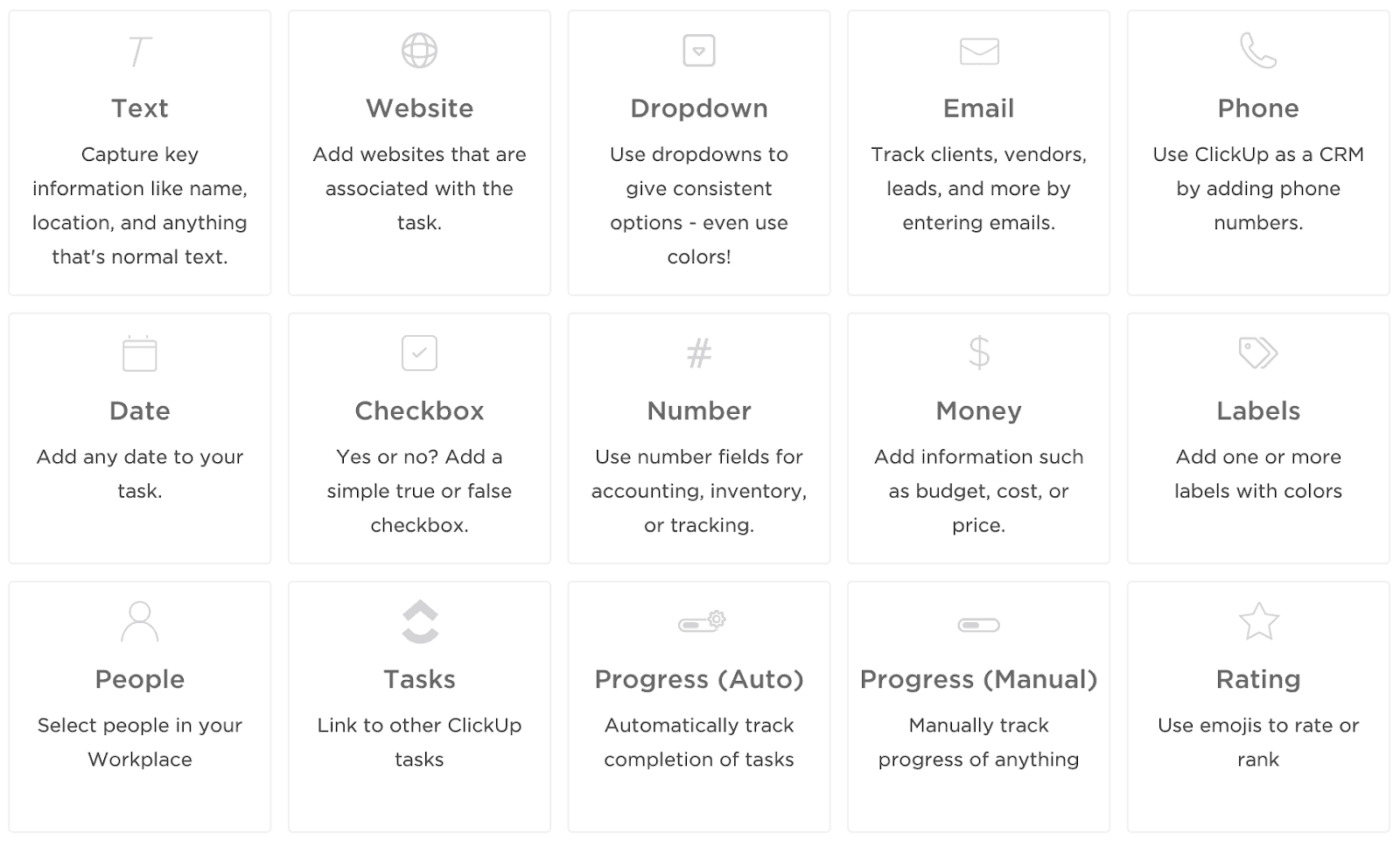
تتبّع البيانات ذات الصلة باستخدام الحقول المخصصة في ClickUp
6. تتبع المقاييس
الآن بعد أن حددت أهدافك، حان الوقت لتتبع المقاييس التي اخترتها. A برنامج مؤشرات الأداء الرئيسية مثل ClickUp سيقوم بذلك تلقائيًا نيابةً عنك، مع الحفاظ على تحديث بيانات لوحة التحكم الخاصة بك.

قم بتخصيص لوحة معلومات ClickUp الخاصة بك للمقاييس التي تريد رؤيتها بالطريقة التي تريد رؤيتها مهام ClickUp يساعدك على تنظيم وتتبع المهام المتعلقة بكل هدف من أجل إدارة فعالة. تعمل واجهة السحب والإفلات البديهية على تبسيط إدارة المهام، وتوفر طرق عرض متعددة للحصول على نظرة عامة شاملة لسير العمل.
بصرف النظر عن طريقة عرض لوحة التحكم, طرق عرض ClickUp تتيح لك أيضًا تصور بياناتك ودراستها بطرق مختلفة. على سبيل المثال، طريقة عرض القائمة (رائعة للتفصيل الدقيق لكل مهمة)، والجدول الزمني (إذا كنت ترغب في عرض المهام حسب التاريخ والمدة)، وعرض عبء العمل، ومخطط جانت، والمزيد.

تنظيم المهام باستخدام خيارات مرنة للفرز والتصفية والتجميع في طرق العرض المخصصة من ClickUp Custom Views
💡 نصيحة احترافية: يمكنك إنشاء مهمة في ClickUp لتذكيرك بتتبع مقاييس مؤشرات الأداء الرئيسية بانتظام.
أو، والأفضل من ذلك، أتمتة هذه المهمة من خلال الاستعانة بمصادر خارجية ل ClickUp Brain هو مساعد الذكاء الاصطناعي المدمج في ClickUp. يمكنك الحصول عليه لتحليل البيانات لتتبع المقاييس وجدولة وإرسال تقارير التقدم الآلي.
يمكنك طرح أسئلة على ClickUp Brain، وسيقوم بالبحث في كل لوحة معلومات في مساحة العمل الخاصة بك لإنشاء الرؤى التي تحتاجها تلقائيًا وبسرعة.
تأكد من وصول جميع أعضاء الفريق المعنيين إلى لوحة معلومات مؤشرات الأداء الرئيسية. تعزز مشاركة لوحة المعلومات الشفافية وتحافظ على توافق الجميع حول أهداف المؤسسة ودورهم في تحقيقها.
هل أنت قلق بشأن الأمان؟ لا تقلق - يمكنك تعيين أذونات المستخدم لتقييد الوصول إلى لوحة المعلومات على الأشخاص المصرح لهم فقط.
7. تحليل النتائج
بعد تتبع المقاييس الخاصة بك لفترة من الوقت، قم بتحليل البيانات لمعرفة ما إذا كنت على المسار الصحيح لتحقيق أهدافك. إذا لم يكن الأمر كذلك، يمكنك اتخاذ قرار سريع بشأن الخطوات التالية.
يتيح لك ClickUp الانتقال بسرعة من نظرة عامة واسعة إلى رؤى تفصيلية باستخدام الفلاتر وميزات التنقل لأسفل في لوحة المعلومات.
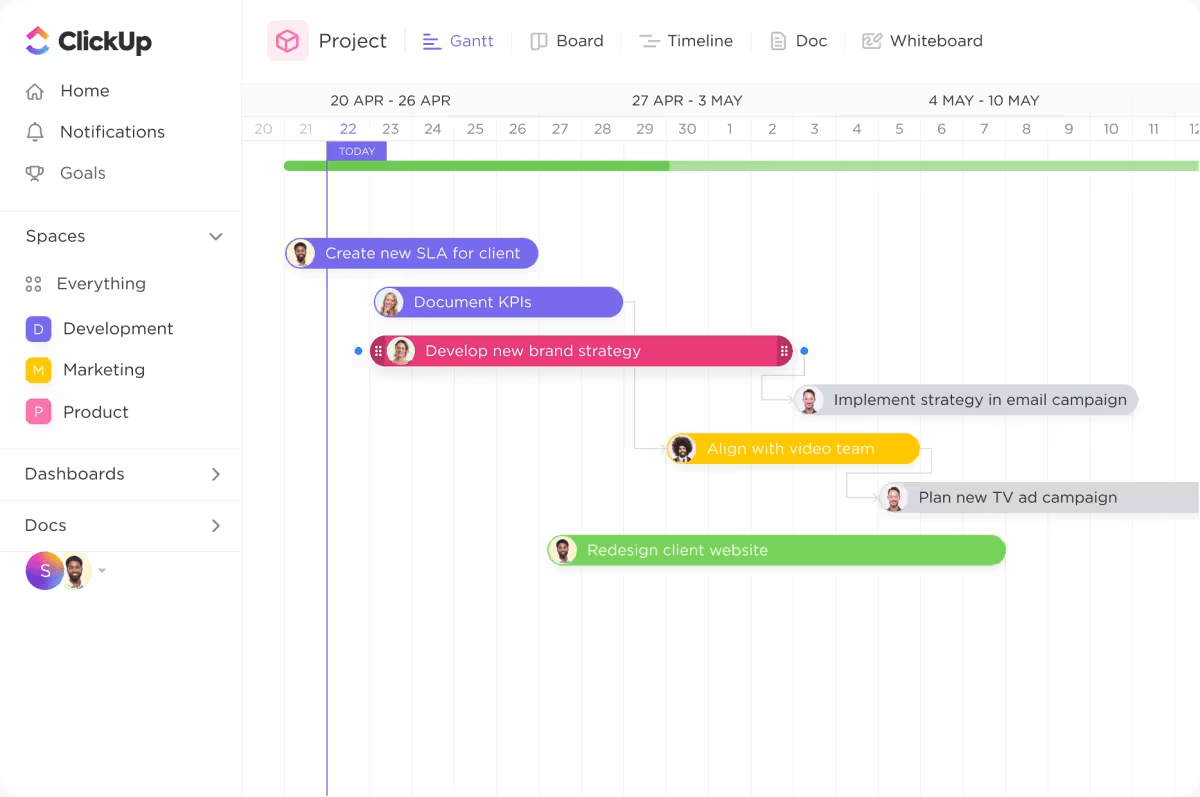
_تتبع التقدم المحرز والمعالم الرئيسية والتبعيات مع فريقك من خلال عرض مخطط جانت البياني ل ClickUp مخططات جانت في ClickUp هي طريقة ممتازة أخرى للحصول على نظرة عامة على جميع مهام مشروعك ومقاييسه ومعرفة أين تحتاج إلى اللحاق بالركب. يمكنك استخدام وظيفة السحب والإفلات لضبط الجداول الزمنية عند الحاجة. كما أنها تساعدك أيضًا على تحديد أي تبعيات للمهام التي تعيقك، والعثور على وقت الركود الذي قد يكون متاحًا.
💡 نصيحة احترافية: اطرح سؤالاً على ClickUp Brain، وسيقوم بالبحث في كل لوحة تحكم في مساحة العمل الخاصة بك ليقدم لك الإجابات على الفور. فكر الآن كيف ستستخدم الوقت الذي تم توفيره 🙌
8. تقييم التقدم
إلى جانب تتبع المقاييس الفردية وتحليلها، من الضروري أيضًا التوقف بانتظام وتقييم أدائك بشكل عام. تساعدك عمليات التحقق هذه على عرض الإنجازات المحققة وتحديد مجالات التحسين.
💡 نصيحة احترافية: قم بتعيين مراجعات أسبوعية أو نصف أسبوعية باستخدام تقويم ClickUp لتقييم التقدم المحرز في مؤشرات الأداء الرئيسية وتعديل المهام والاستراتيجيات حسب الحاجة. عرض لوحة ClickUp تجميع المهام حسب الحالة لمساعدتك على تتبع التقدم المحرز وإجراء التعديلات بسرعة. تجعل الطبيعة المرئية للوحة كانبان من السهل تتبع الأهداف وإدارتها، حتى تتمكن من تحويل التركيز والموارد إلى حيث تشتد الحاجة إليها.
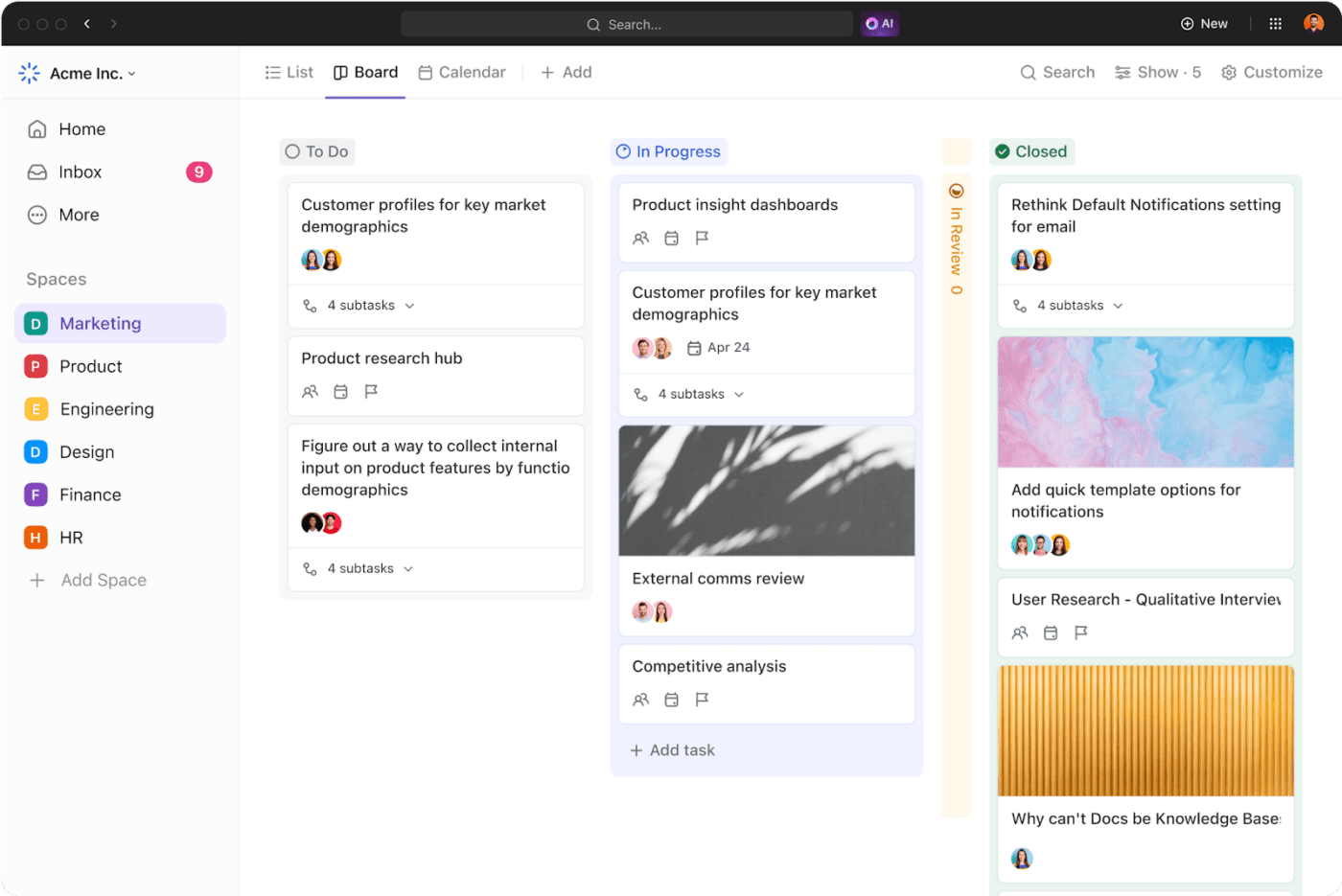
تعرف على حالة مهامك في لمحة سريعة وانقل المهام المكتملة إلى المرحلة التالية بسرعة باستخدام عرض لوحة ClickUp
بعد إجراء التقييم، قد تقرر تعديل أهدافك أو جداولك الزمنية أو حتى تغيير استراتيجيتك. ونظراً لمدى ديناميكية بيئة العمل لدينا، فإن مثل هذه التقييمات تساعد الفرق على مواكبة التغييرات والحفاظ على مرونتها.
💡 نصيحة احترافية: أثناء استخدامك للوحة معلومات مؤشرات الأداء الرئيسية، اجمع ملاحظات من فريقك حول فعاليتها وسهولة استخدامها. ابحث باستمرار عن طرق لتحسين لوحة معلومات مؤشرات الأداء الرئيسية في مؤسستك.
تضمن المراجعات المجدولة بانتظام أن تستمر لوحة المعلومات في تلبية احتياجاتك وتساعدك على الاحتفال بالإنجازات لرفع الروح المعنوية.
استخدام قالب ClickUp KPI
إذن، كانت هذه هي عملية إنشاء لوحة المعلومات باختصار. إذا كنت لا ترغب في قضاء بعض الوقت في إنشاء لوحات المعلومات الخاصة بك، يمكنك أيضًا استخدام قالب ClickUp KPI لإعداد مقاييس النجاح وتتبعها بسرعة لك ولفريقك.
تتبع مؤشرات الأداء الرئيسية وتصورها باستخدام قالب ClickUp KPI
يساعدك قالب لوحة مؤشرات الأداء الرئيسية هذا على:
- الحصول على وضوح بشأن تقدم فريقك نحو تحقيق الأهداف
- التأكد من توافق الفرق والأفراد حول الأهداف
- تتبع الأداء بمرور الوقت باستخدام صور مرئية سهلة القراءة
بعد استيراد قالب لوحة مؤشرات الأداء الرئيسية، خذ بعض الوقت لتخصيصها لتناسب أهداف مؤسستك المحددة والنتائج الرئيسية. يمكنك استخدام حالات مخصصة (مكتمل، خارج المسار، على المسار، لم يبدأ، وفي خطر) و حقول مخصصة (التقدم، القسم، القيمة المستهدفة، القيمة الفعلية، مؤشر الأداء الرئيسي، إلخ) لتحديثها حسب رغبتك. كما أنه يساعدك أيضًا على تتبع مؤشرات الأداء الرئيسية بشكل أفضل من خلال تتبع الوقت والعلامات والأتمتة الأصلية.
في حين يمكن للقادة استخدام عرض الملخص للحصول على نظرة عامة على جميع مؤشرات الأداء الرئيسية وكيفية اتجاهها، يمكن لمديري الأقسام تتبع التقدم المحرز في الأقسام الفردية باستخدام عرض النتائج الرئيسية للإدارة. بالإضافة إلى ذلك، يمكن أن تعرض طريقة عرض التقدم تقييماً متعمقاً لكل مؤشر أداء رئيسي على حدة، بينما تُعد طريقة عرض الجدول الزمني رائعة لتتبع المعالم الرئيسية والمواعيد النهائية. تنزيل هذا القالب
أمثلة على لوحة معلومات مؤشرات الأداء الرئيسية
دعنا نلقي نظرة سريعة على بعض الأمثلة على لوحة مؤشرات الأداء الرئيسية لنرى كيف يمكن استخدامها لمقاييس ووظائف مختلفة.
### لوحة معلومات حملات التسويق

_قم ببناء نظرة عامة على أنشطتك التسويقية باستخدام لوحة معلومات حملات التسويق ClickUp Marketing Campaigns
باستخدام لوحة معلومات حملات ClickUp التسويقية ، يمكن للفرق الحصول على نظرة عامة على مبادراتهم التسويقية الرئيسية دفعة واحدة.
دعنا نفكر في حالة حملة تسويق عبر وسائل التواصل الاجتماعي التي حددت فيها أهدافًا مثلزيادة مدى الوصول والتفاعل والمتابعين.
لتتبع أداء الحملة، يمكنك إنشاء لوحة معلومات مؤشرات الأداء الرئيسية للتسويق لتتبع مقاييس مثل:
- مرات الظهور حسب الأسبوع والشهر
- الإعجابات حسب الأسبوع والشهر
- الإعجابات والمشاركات حسب القناة
- أعداد المتابعين حسب الأسبوع، إلخ.
### لوحة معلومات عامة عن المبيعات

لوحة معلومات عامة مشتركة للمبيعات تضمن أن يكون فريقك دائمًا على نفس الصفحة
يمكنك إنشاء وتخصيص لوحة معلومات عامة عن المبيعات في ClickUp لمساعدة فريق المبيعات الخاص بك على تتبع المقاييس الرئيسية لأعمالك.
على سبيل المثال، يمكنك استخدام أدوات مختلفة لإنشاء تمثيل مرئي لـ
- إجمالي وصافي المبيعات حسب الشهر
- نمو المبيعات حسب المنطقة
- بيانات المبيعات حسب القناة
- معدل الإغلاق حسب الشهر
- معدل التحويل الإجمالي
- المبيعات حسب الفئة أو نوع المنتج، إلخ.
يساعد تتبع هذه المقاييس المهمة مديري المبيعات على البقاء على اطلاع على أرقام المبيعات، واتخاذ قرارات قائمة على البيانات، والحفاظ على توافق الجميع على الطريق إلى الأمام.
مع ClickUp، يكون لكل مندوب مبيعات لوحة تحكم مخصصة خاصة به. ويمكنهم الاطلاع على الكثير من المعلومات المهمة حول تقدم مشاريع عملائهم وتأثير الإيرادات التي لم يتمكنوا من رؤيتها من قبل.
تشارلز فراي، مدير العمليات في QubicaAMF
لوحة معلومات الإنتاجية الشخصية لـ ####ClickUp Personal Productivity Dashboard

أنشئ لوحة معلومات الإنتاجية الشخصية في ClickUp لتتبع عملك الخاص
لوحات المعلومات ليست فقط لتتبع تقدم الفريق. يمكنك أيضًا استخدام لوحة معلومات مؤشرات الأداء الرئيسية لقياس أدائك الخاص.
أنشئ لوحة التحكم الخاصة بك لوحة تحكم الإنتاجية الشخصية ClickUp على طريقتك - أضف الأدوات والبيانات الأكثر أهمية بالنسبة لك. على سبيل المثال، قد يرغب ممثل دعم العملاء في تتبع مقاييس محددة مثل:
- إجمالي عدد الحالات المسندة إليهم
- المهام المفتوحة حالياً لديهم
- المهام التي أغلقها خلال الأسبوع
- متوسط وقت معالجتهم لكل مهمة
- تقييم ملاحظات العملاء الخاصة بهم
هذه طريقة رائعة لأي فرد لمعرفة أين يقضي وقته وما إذا كان ذلك يتماشى مع أهدافه. إذا لم يكن كذلك، يمكنهم بسرعة تصحيح المسار وإعادة تحديد الأولويات والعودة إلى المسار الصحيح.
كيفية استخدام لوحات مؤشرات الأداء الرئيسية للعمل بشكل أكثر ذكاءً
يمكن أن يؤدي تطبيق لوحة معلومات مؤشرات الأداء الرئيسية التي تتعقب المقاييس الرئيسية إلى تحسين الأداء المؤسسي بشكل عام. من خلال الاستفادة الاستراتيجية من لوحات مؤشرات الأداء الرئيسية، يمكن للفرق العمل بشكل أكثر ذكاءً، مما يضمن أن كل جهد يبذل يساهم بشكل مباشر في تحقيق أهداف المؤسسة.
فيما يلي أهم مزايا استخدام لوحة معلومات مؤشرات الأداء الرئيسية بفعالية:
1. تعزيز التواصل بشأن الأهداف الاستراتيجية
غالبًا ما تتطلب الأهداف التنظيمية وأهداف الفريق التنسيق بين مختلف الفرق. وبدون منصة موحدة لعرض الأهداف ومقاييس الأداء، فإنك تواجه خطر سوء التواصل وتكوين صوامع البيانات.
توضح لوحة مؤشرات الأداء الرئيسية الإنجازات الفردية والجماعية والتقدم المحرز نحو تحقيق الأهداف بتنسيق يسهل فهمه. يساعد هذا الوضوح أعضاء فريقك على رؤية مساهماتهم في الأهداف المؤسسية الأكبر، وهذا السياق يحفزهم ويحفزهم على الأداء.
علاوةً على ذلك، تتضمن العديد من منصات لوحات المعلومات أدوات تعاون، مما يقلل من الحاجة إلى تطبيقات الإنتاجية الخارجية ويبسط عملك اليومي.
2. مراقبة الأنشطة بسهولة
برنامج ذكي للوحة المعلومات مع تتبع المهام في الوقت الحقيقي يجعل اجتماعات التحديث الأسبوعية تلك شيئًا من الماضي القديم.
يتم تحديث لوحات المعلومات مثل ClickUp في الوقت الفعلي لتظهر لك حجم العمل المنجز في أي لحظة. لا مزيد من تتبع العمل عبر عشرات جداول البيانات أو انتظار الفرق المختلفة لترسل لك بياناتها حتى تتمكن من تجميعها في عرض واحد!
لتحقيق أفضل استفادة من بياناتك، اختر حلاً للوحة المعلومات يتناسب بسلاسة مع سير عملك الحالي. قد يعني ذلك اختيار تطبيق متوافق يتكامل مع مصادر بياناتك الأساسية أو اختيار منصة شاملة تقدم تقارير مفصلة عن مؤشرات الأداء الرئيسية وتصورات البيانات وسير العمل الآلي.
3. إنشاء فرص للتلعيب
إلى جانب تحليل البيانات، يمكن للوحات مؤشرات الأداء الرئيسية إدخال عناصر ممتعة في سير العمل، وإشراك موظفيك من خلال التلعيب.
A استبيان TalentLMS إلى أن التلعيب يمكن أن يعزز الإنتاجية والسعادة في مكان العمل بشكل كبير، حيث يشعر 89% من الموظفين بأنهم أكثر إنتاجية و88% منهم يشعرون بزيادة في السعادة.
يمكن أن تساعدك لوحة معلومات مؤشرات الأداء الرئيسية في إعداد نظام مكافآت يعتمد على تحقيق إنجازات وأهداف عمل محددة. يمكنك أيضًا دمج أنظمة النقاط ولوحات المتصدرين وعناصر تنافسية أخرى لخلق منافسة صحية، طالما أنها لا تقوض التعاون.
4. تعزيز العمل الجماعي والمساءلة بشكل أفضل
تعالج لوحات مؤشرات الأداء الرئيسية تحديات العمل الجماعي الشائعة، مثل المهام غير الواضحة واختناقات التواصل وعدم وضوح الأهداف التنظيمية الأوسع نطاقًا.
من خلال عرض مؤشرات الأداء الرئيسية الخاصة بك إلى جانب الأهداف ذات الصلة، توضح لوحات المعلومات المسؤوليات الفردية، وتخفف من الارتباك، وتحدد بسرعة أوجه القصور. كما أنها تضمن الشفافية وتبني الثقة داخل مؤسستك.
بالإضافة إلى ذلك، عندما يتمكن أعضاء فريقك من عرض مهام بعضهم البعض، فإن ذلك يشجع على مشاركة المعرفة والدعم المتبادل، مما يعزز العمل الجماعي والمساءلة.
قم ببناء لوحة مؤشرات الأداء الرئيسية من الدرجة الأولى باستخدام ClickUp
تساعد مؤشرات الأداء الرئيسية الفرق على توضيح أهدافها وأدائها اليومي والأسبوعي والشهري والتركيز عليها. كما أنها تساعد الأفراد على رؤية كيفية تأثير جهودهم على الفريق. وعلى العكس من ذلك، فإنها تسلط الضوء أيضًا على المبادرات والإجراءات التي لا تدعم أهداف الشركة وينبغي إلغاء أولويتها.
ومع ذلك، قد لا تناسب مؤشرات الأداء الرئيسية الفعالة لفريق أو حتى منظمة ما فريقًا أو حتى منظمة أخرى. لذلك، نوصي بتحديد أولوياتك واختيار مؤشرات الأداء الرئيسية المناسبة لقياس التقدم المحرز.
يمكن للاستفادة من برامج مؤشرات الأداء الرئيسية المصممة بشكل جيد تبسيط هذه العملية، مما يلغي الكثير من التخمين ويسرّع التقدم نحو تحقيق الأهداف.
ClickUp هو أحد أكثر الحلول سهولة في الاستخدام وفعالية من حيث التكلفة لصياغة لوحات مؤشرات الأداء الرئيسية عالية الجودة. فهو يعمل على ترقية قدراتك في إعداد التقارير بالبيانات في الوقت الفعلي كلما دعت الحاجة، بحيث يمكنك التوقف عن ملاحقة البيانات والبدء في العمل الاستراتيجي. اشترك في ClickUp لتجربة لوحة التحكم اليوم!



